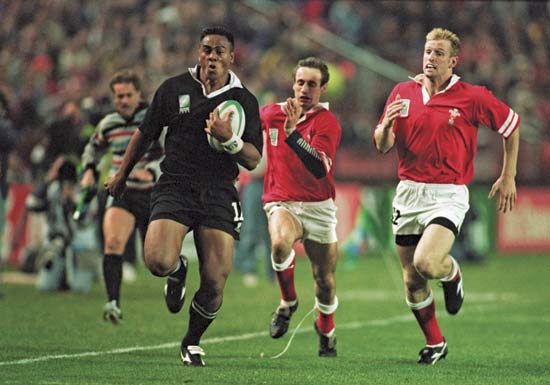The Runner and Field
When
we look at runners on the field, a couple of aspects can be considered:
- Changing directions
- Running in an open field
Changing Directions
on the Field
Let's look at an example of a runner recieving a pass from a teammate.
First, the runner starts
from rest, and accelerates to full speed (22 mi/h
or 9.8 m/s) in 2 s after receiving the ball. His acceleration (a) is:
- a = (vf - vo)/(tf - to)
- vf is final velocity
- vo is initial velocity
- tf is final time
- to is initial time
- a=(9.8 m/s - 0 m/s)/(2 s - 0 s)
- a= 4.9 m/s2
As he runs with the flow of
the play, he maintains constant speed (a = 0). When
he sees an opening, he might plant his foot to stop his motion in one
direction, changing direction and accelerates upfield into the open.
By planting his foot, he applies force to the ground. The force
he applies to
the turf helps to accomplish two things:
- Stop his current motion
- Accelerate him
upfield


To stop his motion in one
direction, two forces work together. First, there is the force that he
himself applies to the turf when he plants his foot. The second force
is the friction between
his foot and the turf. Friction is important to the runners
changing direction. in order to increase the friction players use
cleated shoes. If you have ever seen a match played in the
rain, you have seen what happens to runners when there is little
friction. The following is what happens when a runner tries to change
his direction of motion on a wet surface:
- As he plants his foot to slow his motion, the coefficient of
friction between the turf and him is reduced by the water on the
surface.
- The reduced coefficient of friction decreases the frictional
force.
- The decreased frictional force makes it harder for him to
stop his motion .
- The runner loses his footing and falls.
The applied force and the
frictional force together must stop the motion in one direction. Let's
assume that he stops in 0.5 s. His acceleration must be:
- a = (0 m/s - 9.8 m/s)/(0.5 s - 0 s)
- a = -19.6 m/s2
The
force (F) required to stop
him is the product of his mass (m), estimated at 98 kg (220 lbs), and
his acceleration:
- F = ma = (98 kg)(-19.6 m/s2) = 1921
Newtons (N)
- 4.4 N = 1 lb
- F = 500 lbs
To accelerate upfield, he
pushes against the turf and the turf applies an equal and opposite
force on him, thereby propelling him upfield. This is an example of Newton's
third law of motion, which states that "for every action
there is an equal, but opposite reaction." Again, if he accelerates to
full speed in 0.5 s, then the turf applies 1921 N, or about 500 lbs, of
force.

Running in an
Open Field
When running in an open field, the player can reach his maximum momentum.
Because momentum is the product of mass and velocity, it is possible
for players of different masses to have the same momentum. For example,
our back would have the following momentum (p):
- p = mv = (98 kg)(9.8 m/s) = 960 kg-m/s
For a 125 kg (275 lb) forward to
have
the same momentum, he would have to move with a speed of 7.7 m/s.
Momentum is important for stopping runners on the
field.




